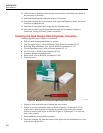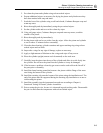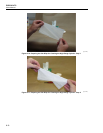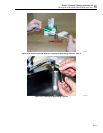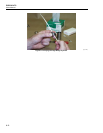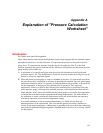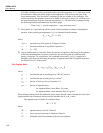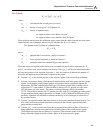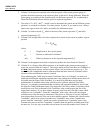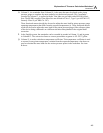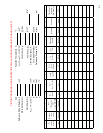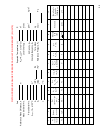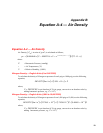
RUSKA 2470
Users Manual
A-4
I. Column 5 is the pressure required at the reference plane of the piston pressure gauge to
produce the desired pressure at the reference plane of the device being calibrated. When the
piston gauge is operating in the absolute mode, the Reference pressure, P
R
, is subtracted to
obtain the differential pressure that the piston is required to generate.
J. The value of
2
21
1
AA
PbPb ++ , which is used to determine the piston area at different system
pressures, is recorded in column 6. For some pistons,
1
b and/or
2
b are equal to zero. Always
observe the sign in front of b
1
and b
2
as found in the calibration report.
K. Column 7 is used to record
)(te
A which is the area of the piston at pressure
A
P
and at the
expected temperature
()
t .
L. Column 8, the weight load, is the force required on a piston of given area to produce a given
pressure
⎟
⎠
⎞
⎜
⎝
⎛
=
te
A
A
P
F
where:
F = Weight load or force on the piston
A
P
= Pressure as indicated in Column 5
()
te
A
= Effective piston area at the expected temperature
()
t .
M. Column 9 is the apparent mass that is required to produce the force listed in Column 8.
N. Column 10 is a listing of the different masses to be loaded on the piston pressure gauge to
create the pressure listed in Column 5. The masses which will be listed here are in addition to
the tare
components (piston, surface tension effects, bell jar reference pressure, etc.). The
mass of the tare components must be subtracted from the mass shown in Column 9 before
selection of the miscellaneous masses is started.
After subtracting the TARE mass from the Total Mass shown in Column 9, we must now
subdivide/distribute the remaining required mass value among the available masses that will
be loaded onto the Piston Table Assembly. It is most likely that there may be many
combinations of available masses that could be used to yield the required Total Mass.
However, it is strongly recommended that an orderly and sequential method by used. From
the Mass Set Table (calibration report) first determine if the Sleeve Mass is required (which
would be the case if the realization of the Total Mass value would require the use of the
larger platter masses). If yes, then subtract its mass value from the Total Mass value which
results in a new "remainder". From this "remainder" mass value, choose the next largest
available mass value that may be subtracted. If the choice is from one of several "nominal"
mass platters then choose the first one in the available sequence. Subtract this value from the
"remainder", which now results in another new "remainder" mass value. Continue this
process until the "remainder", which now results in another new "remainder" mass value.
Continue this process until the "remainder" is smaller than the smallest available mass from
the mass set. At every step, record the selected mass (its mass ID number) into Column 10.



